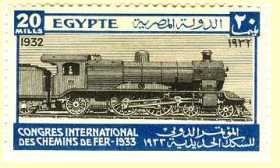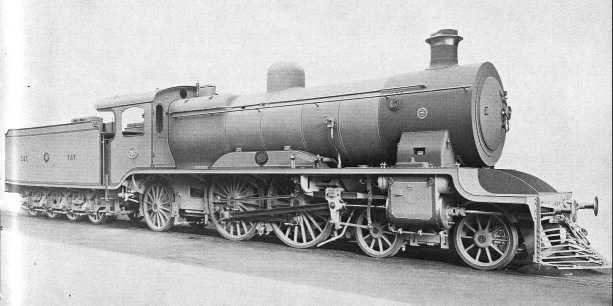 In 1933 the International Railway Congress was held in Cairo and in celebration of this event a very interesting railway museum was opened in an
annexe to the main station at Cairo; the exhibits included three old locomotives (194, 986 and old 30)
and numerous models, photographs and drawings. The museum is still open, from 8.30am to 2pm daily except Mondays
and official holidays, admission 10 piastres. In addition, Professor Lionel Wiener was commissioned
to write (in French) a very detailed history of the Egyptian Railways; this is a fine piece of work ,
Egypt et ses chemins de fer. Well illustrated, it nether less contains a number of small factual errors and misprints, due no doubt to a very
tight time schedule. A set of four excellent postage stamps was issued to mark the occasion, depicting characteristic Egyptian locomotives.
The highest value, 20 millieme, shows engine 787 an Atlantic class 4-4-2, built by North British Locomotive Co. Ltd. (Works No. 23338).
N.B.L supplied 35 of these Atlantics to the E.S.R. in 1925 15 being built against one order and 20
against another. They were designed for express passenger service, their 6ft 6in driving wheels
delivering a traction effort of 19,528 lbs. from a boiler pressure of 160 lb; the large capacity
tender held 5,500 gallons of water and eight tons of coal. Weight (in working order) of engine and
tender was 133 tons 10cwt. Originally numbered 760 to 794, the E.S.R renumbered all their locomotives in 1926
they became No. 6 to 25. They became the mainstay for the Express service and continued in operation well in to
the fifties or later, numbers 47 and 59 being withdrawn in 1943. Some were given names and a suitably impressive
curved nameplate over the driving wheels arches, among them No. 31 Rameses II, No. 33 Thotmos III, No. 44 Prince Farouk
and No. 56 King Faoud I.
In 1933 the International Railway Congress was held in Cairo and in celebration of this event a very interesting railway museum was opened in an
annexe to the main station at Cairo; the exhibits included three old locomotives (194, 986 and old 30)
and numerous models, photographs and drawings. The museum is still open, from 8.30am to 2pm daily except Mondays
and official holidays, admission 10 piastres. In addition, Professor Lionel Wiener was commissioned
to write (in French) a very detailed history of the Egyptian Railways; this is a fine piece of work ,
Egypt et ses chemins de fer. Well illustrated, it nether less contains a number of small factual errors and misprints, due no doubt to a very
tight time schedule. A set of four excellent postage stamps was issued to mark the occasion, depicting characteristic Egyptian locomotives.
The highest value, 20 millieme, shows engine 787 an Atlantic class 4-4-2, built by North British Locomotive Co. Ltd. (Works No. 23338).
N.B.L supplied 35 of these Atlantics to the E.S.R. in 1925 15 being built against one order and 20
against another. They were designed for express passenger service, their 6ft 6in driving wheels
delivering a traction effort of 19,528 lbs. from a boiler pressure of 160 lb; the large capacity
tender held 5,500 gallons of water and eight tons of coal. Weight (in working order) of engine and
tender was 133 tons 10cwt. Originally numbered 760 to 794, the E.S.R renumbered all their locomotives in 1926
they became No. 6 to 25. They became the mainstay for the Express service and continued in operation well in to
the fifties or later, numbers 47 and 59 being withdrawn in 1943. Some were given names and a suitably impressive
curved nameplate over the driving wheels arches, among them No. 31 Rameses II, No. 33 Thotmos III, No. 44 Prince Farouk
and No. 56 King Faoud I.The "Sunshine Express" was a luxury train taking passengers to Upper Egypt in a single night, and Abydos, Dendera, Thebes, Karnak. Luxor, Edfu and Aswan. Combined tickets between Cairo, Luxor, Aswan and Shellal, including fares and sleeper and hotel accommodation, were issued at cheap rates during certain months. There were three trains a day in either direction between Cairo and Luxor, the journey of 340 miles taking about 12 hours. To Aswan and Shellal, there are two trains a day in either direction which covered the distance of 480 miles in about 17 hours. All express trains were formed of bogie corridor coaches. First-class coaches were divided into compartments fitted with electric reading lights. Restaurant, sleeping and Pullman cars were attached to the principal trains. Passengers carried on the Egyptian State Railways in the year 1933-34 numbered over 34 millions.
NBL kept a photographic record, including is one of engine 787
